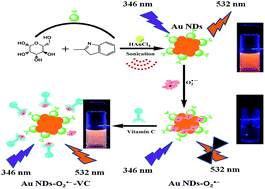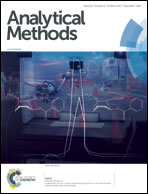Facile sonochemical synthesis of water-soluble gold nanodots as fluorescent probes for superoxide radical anion detection and cell imaging†
Abstract
Determination of the superoxide radical anion (O2˙−) with high sensitivity and selectivity is a challenge for evaluating the role of O2˙− in physiological and pathological processes. Herein, a novel gold nanodot (Au ND) biosensor for detecting O2˙− was developed, which was prepared with D(+)-mannose as the reducing agent and 2-mercaptobenzothiazole as the stabilizing agent via a facile, one-pot and rapid sonochemical approach. The as-prepared Au NDs possess a small size (∼1.9 ± 0.1 nm), and exhibit intense orange fluorescence emission and good water-dispersibility. Interestingly, the Au NDs would react with the superoxide radical anion (O2˙−) which results in quenching of the fluorescence. A good linearity between the fluorescence intensity and O2˙− within the range from 0.6 to 78 μM is found, with a detection limit of 0.445 μM. In addition, the Au NDs exhibited good biocompatibility and low cytotoxicity to HepG2 cells in the MTT assay. Due to their superior advantages of low-toxicity, excellent stability and satisfactory fluorescence, the as-prepared Au NDs have been successfully used in cell imaging. As a result, the present Au ND sensor is successfully used for bioimaging and monitoring of O2˙− changes, and is quite promising for biological applications.



 Please wait while we load your content...
Please wait while we load your content...